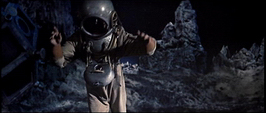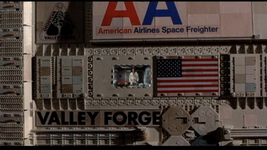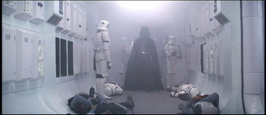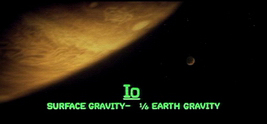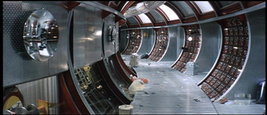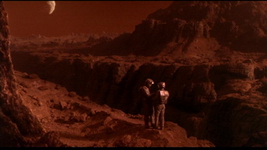Defying Gravity: Space Architecture in Film Environments
The Space Film Genre:
Unlike architecture, film spaces
have never had to be realistic, nor have they been obliged to possess a conscience.
That is not to say, however, that the notions of science or conscience have
failed to be vital motivations behind the creation of many films. Film producers,
though, can make a conscious decision whether to choose to respect scientific
accuracy, and how to portray moral and political conscience. An examination
of the Timelines of Science can begin to allow us to understand the development
of the space genre of film as it relates to accurate scientific invention.
Although classic pieces such as "The Odyssey" could be said to exhibit
early science fictional tendencies, Sir Thomas More has been credited with
the first science fiction/non-dystopic piece, “Utopia”.
Miriam Allen de Ford has
noted: "Science fiction deals with improbable possibilities,
fantasy with plausible impossibilities." And herein lies part
of the blur that we see in the evolution of the Space Film genre. What might
have begun in "Aelita" and "First Men in the Moon" as science fiction in
its attempts to include some recognition of some of the scientific realities
of space, has evolved to become more fantasy based, in the modern" Star Wars"
series of films, which tend to completely ignore any realistic portrayal
of the limits that space environments bring to bear on urban environments
and travel.
The invention
of the modern science fiction novel was not far ahead of the invention of
the motion picture. It is not surprising then, that the space/sci-fi film
genre has its start during the beginnings of the development of the commercial
film industry, and that the scientific development of the film industry sees
its needs propelled by the desire to create more believable science fiction
and space environments. Advanced urban environments, such as those in Fritz
Lang's "Metropolis", also encourage the development of film techniques as
they too stretch the limits of model builders and film makers in their ability
to portray realistic sets. Lang's environments have also influenced the urban
representations of many dystopic films such as "Blade Runner" (1982) directed
by Ridley Scott.
The Role of the Science Fiction Novel:
Early space based science fiction novels, such a "Aelita" by Alexei Tolstoy
(1922) and "First Men in the Moon" by H.G. Wells (1901), had little accurate
scientific information upon which to base their texts. In Aelita the atmosphere
on Mars was harsh, but was not lacking in breathable atmosphere or gravity.
At this point in time the geographic markings that were visible to early
telescopes were thought to be the remains of an ancient canal system, indicating
the presence of water and a far more hospitable climate.
Wells inclusion of scientific knowledge in "First Men in the Moon" was more
accurate, and the film makers in 1964 had benefit of being able to include
state of the art interpretations to aspects of the film due to the contemporary
nature of the "Space Race". Ray Harryhausen's invention of "Dynamation" (green
screening techniques) also allowed the film to more believably mix live action
with realistic looking settings, limiting dependency on simple model views.
There has been constant interaction between science fiction writers and
space genre film production. Arthur C. Clarke worked with Stanley Kubrick
on the screen play for "2001: A Space Odyssey" (in this rare case, the book
followed the film), and Philip K. Dick's short story, "We Can Remember it
Wholesale", provided the basis for the Mars based film, "Total Recall". Current
writers have had up to date scientific knowledge at their disposal, which
makes conscious choice possible when creating accurate versus inaccurate
space environments.
Interestingly, adherence to scientific accuracy has not been the biggest
change in space genre science fiction novels or films. Inclusion
of manipulative aspects of the human mind and perception have replaced the
notion of "conquering the universe", which seems to be a passé topic
for the most part. Space travel has not progressed near to the predictions
of the early science fiction writers, and seems actually to be far from possibility
with the current state of science and the inability to master space travel
technology to reduce problems and fatalities.
Representational Limits in Space Environments in Early
Film:
The art of filmmaking has also undergone a transition from “techniques” to “technologies”.
Early film was reliant on a fixed camera position, fixed lens and the physical
construction of sets and mini models to represent imaginary places. This,
moreso than lack of scientific knowledge about space, severely limited the
portrayal of space environments. This can be clearly seen in "Aelita" --
the novel spends the majority of its pages roaming around Martian landscapes,
and the film does not elaborate on the environment of Mars beyond a few small
glimpses through a window.
Modern Filming Techniques:
Filming techniques today, from the highly accessible iMovie, through to
professional systems used by George Lucas and company, have the ability to
make visual images of environments that blend seamlessly from the physically
constructed full sized set to realistically animated visions of characters
speeding through highly complex urban cities set on unknown planets. This
can be easily seen to have radically changed the appearance of space genre
films through the increase in complexity, speed, layering and realism in
the imagery used.
Maintaining the Traditional View of Architecture:
In spite of the limitless capabilities in film making with the advent of
computer aided drawing and design software, the tendencies in the presentation
of zero gravity environments has normally maintained a gravity driven architectural
solution.
From "Aelita" (1924) to the most recent installment of "Star Wars" (2005),
film has maintained an architectural response to the act of living and building
in space that is almost totally derived from traditions in building on earth.
With the exception of rotating spaces in "2001: A Space Odyssey", the floor
remains the floor, the ceiling the ceiling and the walls the walls. There
are more durable materials placed on the floor than the other surfaces. Barring
some hexagonal and curvilinear anomolies, spaces are rectalinear and familiar
looking. Even the architecture of "Star Wars" has borrowed from the romance
of the Art Deco period in the creation of its powerful urban images.
So with rare exception, it can be seen, that very little in the space film
genre has taken full or any advantage of the lack of restriction in conforming
to the laws of gravity.
Terri Meyer Boake
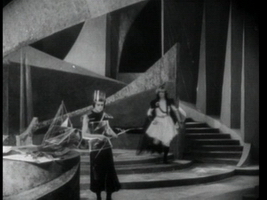
_resize.jpg)
